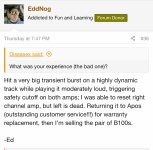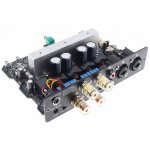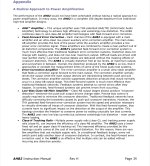I don’t think you can gauge output using a DVM like that. True RMS hand held meters have limited bandwidth and don’t handle the high crest factors present in many types of music.
We had a similar discussion on the forum a few months back. Although the average power may be low in music, you really want to be reproducing the peaks without distortion. You could argue it this way: if the average power of 1W is sufficient for listening, why don’t we just build 1W amplifiers? It’s almost certain that such an amp would be highly compromised and the listening experience pretty lacklustre, even with our 87 dB sensitivity speakers.
We had a similar discussion on the forum a few months back. Although the average power may be low in music, you really want to be reproducing the peaks without distortion. You could argue it this way: if the average power of 1W is sufficient for listening, why don’t we just build 1W amplifiers? It’s almost certain that such an amp would be highly compromised and the listening experience pretty lacklustre, even with our 87 dB sensitivity speakers.
Last edited:
That IW test is just ballpark figure for bulk power effects. If you check the following video, Harley talks about the need for the Amp to be rated higher for the headroom and especially capable of delivering peak power as required by the load. Yes, have done tests with 20W class D ones before and they lacked the weight/control in the delivery
Last edited:
I wrote the opposite, end of post 333. Don't understand the relevance of your headphone amp. The B100's main appeal was already provided in the distortion graphs above. Within its load and power envelope it's the best performance I've seen. Reliability and service, maybe not so much. If you have data for a speaker amplifier demonstrating higher performance or indicating the B100 chokes on non-pathological speaker phase angles, colour me interested.I don't think 2 ohm drive capability should replace SINAD and I didn't suggest one should replace the other - you are selectively misinterpreting my position.
See 👆I wrote the opposite, end of post 333. Don't understand the relevance of your headphone amp. The B100's main appeal was already provided in the distortion graphs above. Within its load and power envelope it's the best performance I've seen. Reliability and service, maybe not so much. If you have data for a speaker amplifier demonstrating higher performance or indicating the B100 chokes on non-pathological speaker phase angles, colour me interested.
I have no idea whether the Tekton DIs, Vandersteen 2Ce or Vandersteen 3A have "non-pathological" phase angles, but I've already posted my user experiences with those 3 pair of loudspeakers.I wrote the opposite, end of post 333. Don't understand the relevance of your headphone amp. The B100's main appeal was already provided in the distortion graphs above. Within its load and power envelope it's the best performance I've seen. Reliability and service, maybe not so much. If you have data for a speaker amplifier demonstrating higher performance or indicating the B100 chokes on non-pathological speaker phase angles, colour me interested.
tl;dr - Unacceptable (to me) as both DIYer with limited knowledge and a casual user.
Separate, but related, I think the claims are misleading, and they likely do not meet FTC guidelines. Since I live in the US, and I purchased the amps in the US, that's the most relevant standard (to me).
I am still working with some old friends at the FTC to determine if direct internet sales (from overseas) fall under the same governance as "brick and mortar" and/or US-based internet sales. When I worked for a US retailer with brick and mortar locations, if we had sold these amps with those claims.... we likely would have needed to pull them.
Personally - I don't give two $hits whether the amps can power X load to Y volume in a room sized Z. I like "flea watt" amps. I just don't use them with the three sets of speakers above. That's for the end-user to decide using their room and their speakers along with their needs. Folks that try to tell people what makes an amplifier "good" (beyond general safety and reliability) are just as bad as the sellers that post ambiguous (or outright misleading) claims.
I still haven't seen any information re: what an accurate power delivery would be if tested to FTC and/or EU standards. All I've seen is that the product fails to meet claims.
Conflations are conflating. You know that amp died due to load conditions? 'Know' doesn't mean the usual unsubstantiated theories spun on the ASR social forum, it means a tear down. Topping has reliability and operability issues, no debate. My DX3 Pro + DAC has demonstrable designs oversights. However, I also banned corporate purchases of Sony consumer audio a quarter century ago because it proved to be unreliable, unsupported trash. Topping isn't unique.Either chokes or dies…
More disconcerting is this bizarre social phenomena of self-proclaimed measurement-only 'science guys', mostly elsewhere, piling on this exceptionally measuring product for being cynically too good, as somehow an opportunist, immoral attempt to game measurements via performance excellence. It's an substantiated conspiracy theory approaching a religious movement. Not good science advocacy by any stretch.
The science-only, measurement zealots are the ones at that other place that defend a poorly performing, demonstrably unreliable product because it excels in just one measurement. This is the same community that shred a Pass commercial amp because it has 0.05% distortion. If you've ever heard one, you'll know it can drive just about any speaker and sound fantastic at the same time.
"piling on this exceptionally measuring product for being cynically too good" - the piling on comes precisely because it has been cynically engineered to excel in one parameter only to the point that overall, it is a flawed product, reliability and other operability issues aside. Practitioners on this forum have designed amplifiers with =<1ppm distortion at rated power that will drive real-world loads. Topping need to up their game and do the same.
"piling on this exceptionally measuring product for being cynically too good" - the piling on comes precisely because it has been cynically engineered to excel in one parameter only to the point that overall, it is a flawed product, reliability and other operability issues aside. Practitioners on this forum have designed amplifiers with =<1ppm distortion at rated power that will drive real-world loads. Topping need to up their game and do the same.
What we "know" is that some people are thrilled with the amps. Some people are not thrilled with the amps.
It's much ado about NOTHING. People can buy amplifiers for whatever reasons they choose using whatever criteria they find most relevant to their end-use, and using whatever sources of information they find most reliable.
Some amplifier evaluation system (however great it may have been) that never saw the light of day is completely irrelevant.
If this amplifier were called a B5 and it had a power delivery claim of 5W into 8R / 4R / 2R and met EU and FTC guidelines for delivering 5W into those particular loads (I have no idea if it will or not) people may praise it for being the best 5W amplifier out there. Who knows, and who cares?
What seems to have everyone's knickers in a twist is the power delivery claims.
These amplifiers absolutely do drive real-world loads; just not EVERY real-world load.
It's much ado about NOTHING. People can buy amplifiers for whatever reasons they choose using whatever criteria they find most relevant to their end-use, and using whatever sources of information they find most reliable.
Some amplifier evaluation system (however great it may have been) that never saw the light of day is completely irrelevant.
If this amplifier were called a B5 and it had a power delivery claim of 5W into 8R / 4R / 2R and met EU and FTC guidelines for delivering 5W into those particular loads (I have no idea if it will or not) people may praise it for being the best 5W amplifier out there. Who knows, and who cares?
What seems to have everyone's knickers in a twist is the power delivery claims.
These amplifiers absolutely do drive real-world loads; just not EVERY real-world load.
Last edited:
Just one look at the internals of that so-called amp should be more than enough to know that heat dissipation alone isn't ever going to cut it. Not possible... even if it was a class D amp with optimised idle losses.
They make extremely unreliable toys with an abundance of feedback to ensure good measurements and then do the product placement on Audioscience review to a handful of naive and inexperienced.
Let them be! Let them enjoy the "product".
They make extremely unreliable toys with an abundance of feedback to ensure good measurements and then do the product placement on Audioscience review to a handful of naive and inexperienced.
Let them be! Let them enjoy the "product".
Missed that one in the shredding of Benchmark because Fosi. Today's punching bag appears to be Buckeye, with a side glance at Purifi. No rest for the puritans.community that shred a Pass commercial amp
Re: the Topping, as the graph above shows and simplistic 1 kHz 5 watt SINAD shootouts notwithstanding, with common moderate loads that amp demonstrates exceptional and invariant performance at all powers and frequencies below 50 watts. Any amp capable of that tops the SINAD shootout.
Cool. Now do today's golfing panther amp.that so-called amp
Attachments
Still going good with the B200? listening impressions?IMD -20dB lower on the Topping B200, crosstalk zero if using monoblocs than using a single AHB2.
https://www.audiosciencereview.com/...er-low-gain-multitone-measurement-png.337826/
https://cdn.prod.website-files.com/62c3bb6dd801788403ab8f8e/66cd452bff9339e70ddc2486_668b904180ec750137b5eb11_B200%20-en-13.jpeg
https://www.audiosciencereview.com/...er-low-gain-crosstalk-measurement-png.337828/
I have both, B200 for 5 days.
Yamaha AS2000.>Hypex NC400>Neurochrome Mod 86 bridged>Benchmark AHB2>Topping B200.
All through Topping Pre90 into fully tricked Quad 989 ESL's.
I was considering the B100 for a part in multiway active setup, but having an amp that dies during normal operation is a simple nogo.
Another nogo is the input implementation. Balanced interconnection does not require voltage swinging on both leads. The name "balanced" comes from balanced impedance, not voltage. (And balanced voltage would be 0 after differential, so it would need to be called antibalanced) Having B100 fail at proper input handling, I don't feel safe plugging it into my system. Who knows what other quirks there are to blow things up.
Yeah, it's BTL, which explains the minimum load of 4 Ohms, that being 2 Ohms apparent for each module. I guess it takes a class D to confidently drive such low impedance loads.
Another nogo is the input implementation. Balanced interconnection does not require voltage swinging on both leads. The name "balanced" comes from balanced impedance, not voltage. (And balanced voltage would be 0 after differential, so it would need to be called antibalanced) Having B100 fail at proper input handling, I don't feel safe plugging it into my system. Who knows what other quirks there are to blow things up.
Yeah, it's BTL, which explains the minimum load of 4 Ohms, that being 2 Ohms apparent for each module. I guess it takes a class D to confidently drive such low impedance loads.
Yeah, watching these beauties and thinking already about my DIY 5.1.2 Atmos setup, perfect amps for each channel.Cool. Now do today's golfing panther amp.
A5
480-1-29A
260-2-29A
These PFFB-equipped TPA3255 designs are of highest price/performance value I think.
The question is how they sound ? Seeing their measurements I assume they're just as transparent as the Hypex NCORE amps (I've heard quite some now). Natural, beautifully precise, well controlled bass, etc.
With growing reports of B100 failures those 3e board are an attractive and inexpensive play around option. I may do a desktop unit. My comment though was more related to the ill advised social phenomena of holding the B100 to standards that amps the same people deem superior don't meet, like 'big fins'. Not a credible look.
These PFFB-equipped TPA3255 designs are of highest price/performance value I think.
I bought the Fosi V3's soon after this thread started. They are great for the $. My DIY class AB monsters are parked. Perhaps permanently. In this system they are powered up for days on end so class D much better. Also balanced connection out of the DAC. No pre-amp. More than adequate for my application.
Cool. Now do today's golfing panther amp.
That is the first time I have seen nicely implemented TPA3251. 3e Audio has had enough time spent with that particular IC product family to produce a very nice integrated amp. I personally appreciate the fact that it has 2 inputs and a volume control. But, what I really like is the layout, construction, parts used, and specifications are also very good - the crosstalk figure on its own shows a carefully laid-out PCB with proper segregation. So, yeah... if I ever decide to get a cheap amp for the kids' bedrooms, this (A5 balanced version) might be an amp. I do have only 3 concerns: No1 is that black stuff they used to cover what I assume is the PFFB global feedback passive and active components - will it cause electrical shorting/loading issues? ; No2 is the fact that heavy stuff like chokes will be hanging upside down for a long time. Probably okay, but it is a concern, nevertheless, if the amp gets bumped/exposed to vibrations like... bass shaker 🙂; No3 - the cost (ouch!).
... I checked what else I could get for AU$500... hmmm.
Still going good with the B200? listening impressions?
A couple of weeks in now and sounding mighty good, driving 'real world' loudspeakers, well they are the size of a door....
Driving to Faithless concert levels of volume and nothing has blown up and the amps barely rise above ambient temperature.
My Quad 989'ESL's have impedance that drops below 4 Ohm, so I emailed Topping and asked if that would be OK. got a reply next day.
https://www.stereophile.com/images/archivesart/quad989fig1.jpg
Maybe if those assuming that using a Pseudo balanced input was OK.for the B100's did likewise then some of the 'these are rubbish' claims would be avoided....
The complete lack of crossover distortion was a little different to what I have been used to. But when you think about it that's how it was recorded.
I am talking about the Topping B200 class AB amplifiers, as opposed to the B100 class B amplifiers as some seem to confuse the two.
- Home
- Amplifiers
- Solid State
- Topping B100


